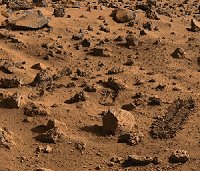
April Editorial

April Editorial
Spectrometric analysis of Martian surface |
|
In August last year we reported on the new revolutionary spectrometer: CRISM. NASA included this on the Mars Reconnaissance Orbiter spacecraft which was launched on the 12th of August 2005. CRISM was to report on the geological composition of Mars. But for once NASA may have been beaten to it by a European spacecraft, which also contains a spectrometer on board. This month Science magazine reported the findings of Dr Jean-Pierre Bibring and his colleagues from the Institut d'Astrophysique Special in France, on the surface composition of Mars. The data has been gathered by the Mars Express - a craft built by the European Space Agency and launched in 2003. The data acquired by the spectrometer has been sufficient to create a detailed geological map of the surface of Mars. Probably the most important finding of Dr Bibring and his co-workers was the presence of secondary rocks, including clays, that were formed by multiple processes. Clays are of special importance since they can only form when water has been standing for a long time. Such places are most suited for the development of organic matter. The results suggest that clays were the earliest secondary minerals to form. Although it is not possible to say precisely when they formed, Dr Bibring estimates that the process started shortly after the formation of Mars (about 4.5 billion years ago). It is possible that at this early geological stage Mars was almost completely covered by clay and a large reservoir of water. The next geological era of Mars was characterized by highly volcanic activities which started about 4 billion years ago. This huge volcanic activity lasted only few hundred million years, but the amount of sulphur rich gasses released created a very acidic atmosphere. Although at that time the water was not that readily available, some must have been present since sulphate minerals, which formed during that time, require water. After this relatively short volcanic era, surface oxidation started giving rise to the ferric-oxide minerals that are responsible for the characteristic red appearance of the planet. This era has lasted until present times. On water is scarce and no longer exists in liquid form on the surface. In summary, the data acquired by the spectrometer shows that Mars has had, so far, three geological eras: the early clay formation; the volcanic era and the last oxidative era which still continues today. |
| _______________________________ | ||||
| Home | | | Shopping | | | Database |
© Biscuit Software 2004-2015
All rights reserved